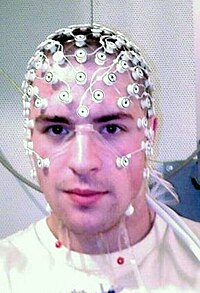
Photo from wikipedia
ObjectivesAnterior alpha asymmetry is an EEG measure of relative left- or right-sided prefrontal cortical activity that has been associated with affective style, such that greater relative left-sided activity is associated… Click to show full abstract
ObjectivesAnterior alpha asymmetry is an EEG measure of relative left- or right-sided prefrontal cortical activity that has been associated with affective style, such that greater relative left-sided activity is associated with positive affect and approach-related behaviours. While mindfulness has been shown to enhance attention and affect, here we investigate the underlying neurobiological changes supporting these outcomes by assessing anterior alpha asymmetry.MethodsA longitudinal RCT was conducted to investigate the effect of an 8-week mindfulness training (MT) intervention on anterior alpha asymmetry and affect in a group of healthy adults aged over 60 years (n = 41). An active control computer-based attention training (CT) program (n = 26) designed to activate similar attentional components to mindfulness was used to determine if outcomes resulted from attention training or mindfulness-specific factors. The Sustained Attention to Response Task was used to assess attentional performance, while a breath counting task was used to classify mindfulness participants into high (MT-HIGH; n = 19) and low (MT-LOW; n = 22) proficiency groups.ResultsWhile all groups displayed improved attentional performance, only the MT-HIGH and MT-LOW groups showed significant increases in positive affect as measured by the Positive and Negative Affect Schedule. The MT-HIGH group showed significantly increased relative left-sided activity at both Fp1/Fp2 and F3/F4 electrode pairs, while no significant changes were observed in the MT-LOW and CT groups.ConclusionsThese results suggest that 8 weeks of mindfulness training is capable of inducing changes in resting anterior alpha asymmetry, but these results are dependent upon the level of proficiency achieved.
Journal Title: Mindfulness
Year Published: 2019
Link to full text (if available)
Share on Social Media: Sign Up to like & get
recommendations!